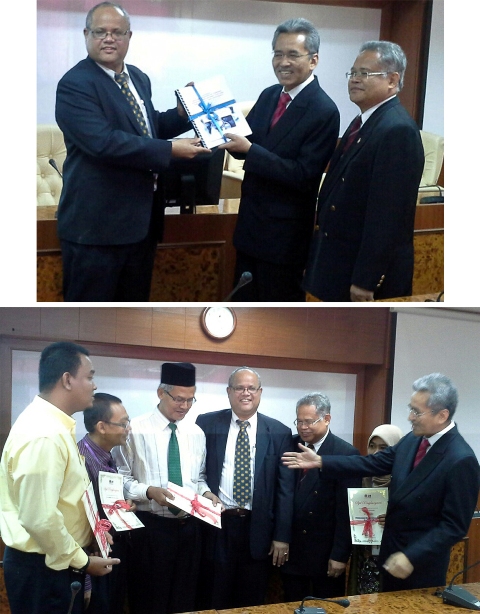USM LAUNCHES HUSM TARIFF USING CASE-MIX SYSTEM

KOTA BHARU, 9 June 2013 - Universiti Sains Malaysia (USM) has officially launched the Hospital USM (HUSM) tariff using a case-mix system. Its launch was officiated by the Vice-Chancellor, Professor Dato’ Dr. Omar Osman in the School of Medical Sciences Conference Room here today.
Also present were Fellow Senior Researcher and Deputy Director of the United Nations University - International Institute of Global Health (UNU-IIGH) Professor Dato’ Dr Syed Mohamed Al Juned; HUSM Director Dato’ Dr. Zaidun Kamari; the School of Dental Sciences Dean, Associate Professor Dr. Adam Hussein; School of Health Sciences Senior Lecturer, Associate Professor Dr. Rosminah Mohamad as the project leader; and senior officers from USM and UNU-IIGH.
In his speech, the Vice-Chancellor said that health care should be given attention and become the main agenda for the welfare of our country.This is why USM always give top priority to this effort either by offering education or medical services in HUSM which acts as a teaching hospital and the main reference centre in the east coast and in the country.
“Efforts to use the hospital tariff that utilises a case-mix system software were made through a collaboration with UNU-IIGH since 2011 and officially through an Memorandum of Understanding signed the following year,” said Omar.

HUSM tariffs are exclusive to this hospital which facilitates the hospital’s management to assess and manage the financial affairs and management of the hospital. This is to achieve the objectives of the implementation of Case-Mix System in improving the quality and effectiveness of health care services provided in the hospital.
The hospital management can also set the benchmark of quality and measure the resource usage for HUSM and that will improve the efficiency and quality of health care service system in HUSM.
“This is expected to save the overall cost of patient management by 10% per year that can be used to improve the quality of patient’s overall well-being,” added the Vice-Chancellor.
The implementation of this system directly provides complete documentation to fulfill the accreditation requirements of HUSM. It is expected that health care services provided by the hospital will be of better quality, being more efficient, harmonious and affordable to the entire community.
In other words, a medical officer now has protocols and work processes that can help patients know the expected duration they have to be hospitalised, drugs that are used according to schedule, a more accurate and organised planning of treatment to be reviewed and monitored by the hospital’s management.
This tariff was successfully launched with the coding effort based on about 93,000 patients’ medical history data over a three-year period (2010-2012). The effort successfully classifies 789 groups or disease treatment. On an average, there were 30,000 cases per year in HUSM from its 23 departments and clinics.
The interesting point is the success of the group working on the implementation of the HUSM tariff which successfully reduced errors to only 10% in coding, compared to 30% when it was first introduced at a different teaching hospital in 2002.
Meanwhile, Professor Dato’ Dr. Syed Mohamed Al Juned said that this success is very meaningful and he was satisfied with the cost classification according to standards that were set, the efficiency and cost effectiveness achieved.
“The important thing is that besides patient management cost saving, it also improved the quality of services rendered,” he said.
In Malaysia, apart from the HUSM, Hospital UKM is the only other hospital that implemented the use of a case-mix system although it has been widely used in 18 countries including Uruguay and Chile, while in Indonesia about 1,262 hospitals have been using this since 2006.
This success enables information access to the basic cost, the duration and treatment of the patients basing on the classification of the disease offered by Case-Mix System. The system of classification is based on the series of treatment received by patients.
According to the project leader, Dr. Rosminah Mohamad, the concept of this system is to facilitate the diagnosis of patients which is generally complex to include these patients under one category of the same diagnosis which is clinically meaningful, using the same resource in a given treatment.
The collection of diagnosis is done using an innovative software, UNU-CBG Grouper that categorises patients’ conditions according to type of disease (Case-Based Group [CBG]).
This process takes into account important variables including primary diagnosis, clinical procedure code, gender, age and also the presence of complications and patient’s medical complications. Each CBG produced is considered as an equivalent as the requirements from clinical resources and economic points-of-view.
This is why the average number of sources used for each diagnosis group can be identified precisely.
Rosminah added that the benefits obtained by the hospital management are among the improvements in health care services in the hospital. The quality of health care and Health Management System in the hospital has improved.
With the implementation of the case-mix system in HUSM, resource distribution is calculated based on the average cost of the treatment given to each CBGs group. The cost for patients in each department at the hospital are calculated based on the weightage of each patient’s case with specific conditions observed at the department and classified according to clinical diagnosis.
The interesting point is that this system provides a CBG exclusively for one patient per treatment episode. UNU-CBG is also known as Malaysian DRG (MY-DRG) in Malaysia.
The complexity in the system resulting from the set of categories of patients (CBG) with similar criteria such as severity of illness, mortality risk, prognosis, treatment difficulty level, the need for intervention and rate of the resources used to treat certain diseases.
“Each MY-DRG has its own cost which includes all of the services involved in the treatment of the case which becomes the actual cost in the treatment spectrum given for each case at the HUSM and it is known as MY-DRG tariff or Hospital USM tariff,” said Rosminah.
- Created on .
- Hits: 1789
